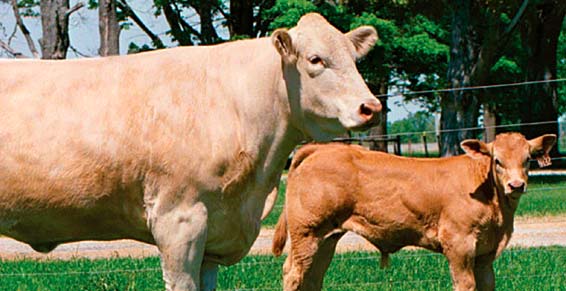Blonde Genetics
Blonde d’Aquitaine arrived in Canada, from France, in the early 70’s at the end of the importation era of continental cattle from Europe. At the time of the first imports, the Blonde breed in France was one of the smaller breeds in number. Blondes are now the third largest beef breed in France.
Blondes, a large, high performance breed, excelling in lean meat yield, have been bred with calving ease in mind. Their fine-boned bodies have been bred to be longer and leaner at birth to facilitate easier calving. While well know in countries around the world for their well-muscled, high-yielding carcasses, the Blonde calf does not start to show the heavier muscled hind quarter, until it is four to six weeks of age.
Voluntary breeder participation in Performance tracking provides EPDs for birth, weaning and yearling weights, milk, a number of carcass traits (using ultrasound technology) and scrotal measurement.
Fullblood polled Blonde genetics have contributed to the Herd book in Canada and are marketed worldwide via semen, embryos and by live animals into the United States.
All registered fullblood Blondes in Canada are parentage verified by DNA.Crossbreeding with Blondes adds muscle, length and thickness in the calves, produces more beef, less fat, less bone and supplies a high-yielding carcass. Crossbred Blonde carcasses have a high Commercial Index Superiority, high meat density, heavier meat to the carcass, leaner meat (3.7% less fat at the 11th rib): heavier muscling (5.9% more muscle on the 11th rib): less bone (2.2% less on the 11th rib): and excellent lean to fat ratio. Blondes cross extremely well with dairy breeds, increasing muscling immensely.
Crossbreeding with Blondes adds muscle, length and thickness in the calves, produces more beef, less fat, less bone and supplies a high-yielding carcass. Crossbred Blonde carcasses have a high Commercial Index Superiority, high meat density, heavier meat to the carcass, leaner meat (3.7% less fat at the 11th rib): heavier muscling (5.9% more muscle on the 11th rib): less bone (2.2% less on the 11th rib): and excellent lean to fat ratio. Blondes cross extremely well with dairy breeds, increasing muscling immensely.

